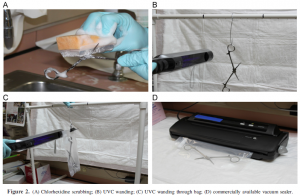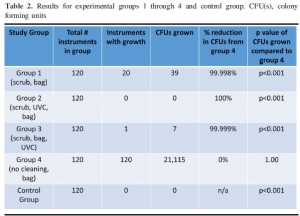15/07/2015
Chlorhexidine et UVC: Pour décontaminer ses instruments
A Novel Method to Decontaminate Surgical Instruments for Operational and Austere Environments
Knox RW et Al. Wilderness Environ Med. 2015 Jul 9. pii: S1080-6032(15)00146-5
---------------------------------------------
On connait l'efficacité des UVA pour décontaminer l'eau de boisson. Cette capacité est mise à profit dans la méthode SODIS. Les UVC sont également intéressants. En effet décontaminer son matériel chirurgical sans autoclave ou appareil à chaleur humide n'est pas impossible. En situation isolée l'emploi combiné d'antiseptique et d'UVC est efficace. C'est ce que démontre ce travail.
---------------------------------------------
OBJECTIVE:
The purpose of this investigation was to test a field-expedient, cost-effective method to decontaminate, sterilize, and package surgicalinstruments in an operational (combat) or austere environment using chlorhexidine sponges, ultraviolet C (UVC) light, and commercially available vacuum sealing.
METHODS:
This was a bench study of 4 experimental groups and 1 control group of 120 surgical instruments. Experimental groups were inoculated with a 106 concentration of common wound bacteria. The control group was vacuum sealed without inoculum. Groups 1, 2, and 3 were first scrubbed with a chlorhexidine sponge, rinsed, and dried. Group 1 was then packaged; group 2 was irradiated with UVC light, then packaged; group 3 was packaged, then irradiated with UVC light through the bag; and group 4 was packaged without chlorhexidine scrubbing or UVC irradiation. The UVC was not tested by itself, as it does not grossly clean. The instruments were stored overnight and tested for remaining colony forming units (CFU).

RESULTS:
Data analysis was conducted using analysis of variance and group comparisons using the Tukey method. Group 4 CFU was statistically greater (P < .001) than the control group and groups 1 through 3. There was no statistically significant difference between the control group and groups 1 through 3.

CONCLUSIONS:
Vacuum sealing of chlorhexidine-scrubbed contaminated instruments with and without handheld UVC irradiation appears to be an acceptable method of field decontamination. Chlorhexidine scrubbing alone achieved a 99.9% reduction in CFU, whereas adding UVC before packaging achieved sterilization or 100% reduction in CFU, and UVC through the bag achieved disinfection.

Les commentaires sont fermés.